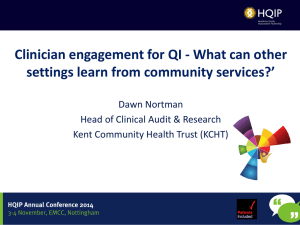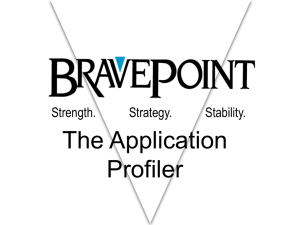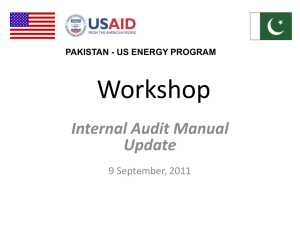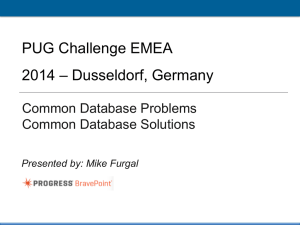Presentation
advertisement
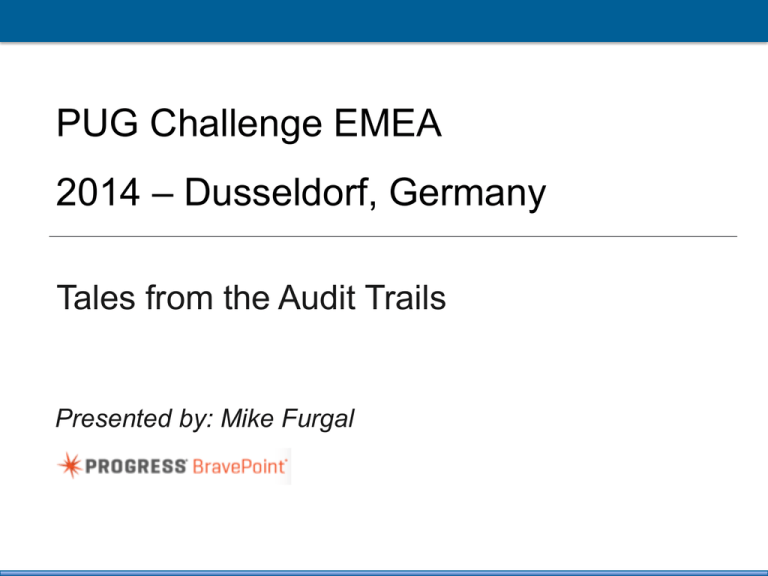
PUG Challenge EMEA 2014 – Dusseldorf, Germany Click to edit Master title style Tales from the Audit Trails Presented by: Mike Furgal 1 PUG Challenge Americas 2014 Introductions • Mike Furgal – Progress employee from 1989 • Short time at Bravepoint from 2012 until 2014 – Progress OpenEdge Database Expert – mfurgal@progress.com 2 PUG Challenge Americas 2014 Introduction - BravePoint • Managed Database Services • • • 1100+ Databases 50+ TB in DB space 75,000+ connected users Pro2 Replication • • • 3 Real Time Replication SQL target 600+ Deployments PUG Challenge Americas 2014 Disclaimer • • The techniques covered in this presentation are directed at the users and administrators of OE applications. Out of scope topics include: – Establishing Trusted User Identity – Adding Auditing Events to an application 4 PUG Challenge Americas 2014 Why Auditing? • Regulatory requirements… – – – – – • • 5 SEC (Sarbanes Oxley) FDA (CFR 21 Part 11) HIPAA Immigration (I-9s) And more Security Peace of mind PUG Challenge Americas 2014 Auditing Options • • “Roll your own” ABL based solutions OpenEdge Auditing • Let’s do a Poll: – – – – 6 Who has an audit system? Who’s audit system is written in the ABL? Who’s already using OE Auditing? Who wishes they had auditing on their OE application? PUG Challenge Americas 2014 “Roll your own” Solutions – Typically use Replication or Database Triggers – Pros • Program in the ABL • Very fine control – Cons • • • • • 7 May require access to application source code Defeatable/insecure High overhead Complications (SQL access for example.) Triggers are client based PUG Challenge Americas 2014 OpenEdge Auditing • Integrated in the product since 10.1A – No additional $ cost • Built into the Database Engine – Low overhead – Supports both ABL and SQL transactions • • • Secure and tamper proof Tools for archiving and reporting Unimpacted by ABL code constructs – ie: DISABLE TRIGGERS 8 PUG Challenge Americas 2014 OpenEdge Auditing • Comprehensive Auditing Solution – Table based Auditing – Field Based Auditing – Allows capture of Before and After versions of the data • • 9 Auditing includes Security so there is no tampering with data Some reporting capabilities built into the product PUG Challenge Americas 2014 What does OE Auditing track? • Changes to... – The Database Schema – The Application Data – Application Defined Events – The Security (New users, deleted users) – Database Encryption – The Audit Policies 10 PUG Challenge Americas 2014 Where is the data stored? • Auditing adds tables to your production DB – Audit trail data is stored in: • _aud-audit-data • _aud-audit-data-value – Audit policy and controls are stored in: • _aud-audit-policy • _aud-event • _aud-event-policy • _aud-field-policy • _aud-file-policy 11 PUG Challenge Americas 2014 What does basic Audit Data look like? _Audit-data-guid |"/unygEGMpaXiEXSzdJPDfQ" _Database-connection-id |"/unygEGMpaXiEXSzOlqlcw" _Client-session-uuid _User-id _Audit-date-time |"" |"root" |2013-10-02T18:06:08.208-04:00 _Audit-event-group _Db-guid _Transaction-id |"" |"4f5kvLayZrXiEXKzHE+akA" |403 _Transaction-sequence _Event-id _Event-context |0 |5101 |"PUB.Customer^F84" _Application-context-id _Event-detail |"" |"Credit-Limit^F5^F12345^F22222" _Audit-custom-detail |"" _Audit-data-security-level _Data-seal 12 |0 |"" PUG Challenge Americas 2014 What is in the _Event-detail field? • It can be a little… "Credit-Limit^F5^F12345^F22222" • Or a lot…. Cust-Num^F4^F71^F^GName^F1^Fpocket billiards co.^F^GAddress^F1^F44 Saunders Ave.^F^GAddress2^F1^F^F^GCity^F1^FPhelan^F^GState^ F1^Fca^F^GCountry^F1^FUSA^F^GPhone^F1^F(818) 6664063^F^GContact^F1^FLeon Aida^F^GSalesRep^F1^FKIK^F^GComments^F1^F^F^GCreditLimit^F5^F5000^F^GBalance^F5^F0^F^GTerms^F1^FNet3 0^F^GDiscount^F4^F50^F^GPostal-Code^F1^F92371^F" 13 PUG Challenge Americas 2014 Enable Audit on the Database 14 • • Shutdown and backup database Add storage areas for audit data and indexes • Enable auditing (with indexes inactive!) PUG Challenge Americas 2014 Define Audit Policies • 15 Use Audit Policy Maintenance Tool in GUI OpenEdge PUG Challenge Americas 2014 Determining Auditing Requirements • • • • • • 16 What type of things do you want to audit? How long do you keep your audit data? What performance impact can you tolerate? How does auditing fit into your disaster recovery plan? Who can access or manage your audit rules and data? What type of reporting/inquiry is required? PUG Challenge Americas 2014 Roles and Responsibilities • The auditing system requires an administrator – Best practice for this position has it as separate person from the DBA • The administrator designates who can: – Administer the audit rules – Report on audit data – Archive or delete audit data • 17 Requires use of OE security PUG Challenge Americas 2014 The Audit Data • The audit tables have 27 indexes defined – Best practice is to have most turned off in production – We’ll see why in a moment • • • 18 Effective reporting requires that these indexes be active. Having the audit data in an archive database allows for reporting without negatively impacting production OpenEdge provides tools to securely move data into the archive database. PUG Challenge Americas 2014 Overhead of Auditing • Customer example: QAD System – Real world audit policies – Inventory Load (36.15.1&.2) • Tested 5 scenarios: – – – – – 19 Baseline without auditing Auditing w/indexes inactive Auditing w/indexes active Auditing w/indexes inactive using value table Auditing w/indexes active using value table PUG Challenge Americas 2014 BI Logging BI Mb Logged 60 50 40 30 BI Logged 20 10 0 QAD No Auditing 20 QAD Audit No-Index QAD Audit w/Index QAD Audit/Value no Index QAD Audit/Value w/Index PUG Challenge Americas 2014 Record Creates & Locks Creates and Record Locks 450000 400000 350000 300000 250000 Creates Locks 200000 150000 100000 50000 0 QAD No Auditing 21 QAD Audit No-Index QAD Audit w/Index QAD Audit/Value no Index QAD Audit/Value w/Index PUG Challenge Americas 2014 Overhead of Auditing on DB Size • Keeping audit history in production may not seem significant 5 GB database Application Data 5gb 15gb Audit Data 22 PUG Challenge Americas 2014 Overhead of Auditing on space 25 GB Database • 25gb As the database grows Audit data takes up an immense amount of space 75gb 25 GB of Data 2 • Archiving out audit data keeps the database at an appropriate size 23 25gb This will generate a lot of BI/AI activity PUG Challenge Americas 2014 Archive Commands 24 • To periodically archive data out of production ready to load into the archive database • To load the exported audit data into the archive database PUG Challenge Americas 2014 Caveat It is not possible to truncate an area that contains Audit data. OpenEdge 11.2 proutil <db> -C auditreconfig [ tablearea <name> ] [ indexarea <name> ] Recreates a new Audit Area and moves all audit data to the new area 25 PUG Challenge Americas 2014 Reporting from Audit Data • Things to consider: – Do you report off production? – Do you report off archive – Do you report from both? • Timeliness of the incident being analyzed – Can alerts be set up? – This is a “roll your own” activity 26 PUG Challenge Americas 2014 OE Reporting Options 27 PUG Challenge Americas 2014 DEMO • • • Start with a Sports database Enable Auditing Use Audit Policy Maintenance Tool – Audit customer table – Audit changes to customer max-credit • • • 28 Create a workload on db Polling process watching for changes to max-credit in _aud-audit-data Change the max credit and see what happens. PUG Challenge Americas 2014 DEMO 29 PUG Challenge Americas 2014 Caveats • Make sure you use deactivateidx on the production database audit tables – Spelling counts!!!! – If you rebuild all indexes all 27 audit indexes become active!!! • Index rebuild causes worse performance • You need to retune both BI and AI – Think about OE Replication and AI size impacts • • Don’t forget your audit policies during a dump/load! Managing 2 databases (production and archive) – Backups – Space management – Recovery Plans 30 PUG Challenge Americas 2014 Conclusions • • • OE Auditing is a powerful tool Knowing what needs to be audited may not be obvious Use an iterative approach – Audit less than you need to start – Ramp as needed • • 31 Make sure you have a solid data management plan Report and alert as needed PUG Challenge Americas 2014 Thank You! Questions? 32 PUG Challenge Americas 2014




